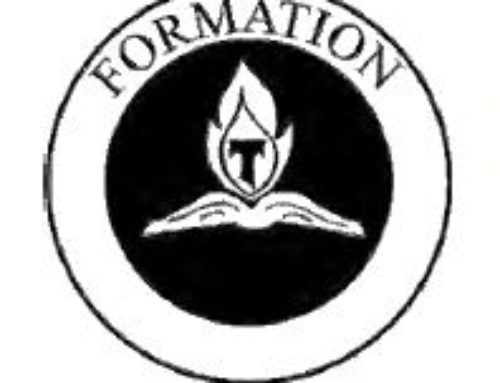By Deacon Tom Bello, OFS
At every step in following the Franciscan Way, from Inquiry to Ongoing Formation, in prayer, one should journey with Sacred Scriptures in one hand and the Secular Franciscan Rule and General Constitutions in the other hand, and with both eyes, as clearly as possible, focused on Christ and Francis.
The very first words of “Chapter Two: The Way of Life” of the Secular Franciscan Rule offer sufficient justification for such a stance: “The rule and life of the Secular Franciscans is this: to observe the gospel of our Lord Jesus Christ by following the example of St. Francis of Assisi who made Christ the inspiration and the center of his life with God and people.”
Thus, in this reflection on the importance of the concept of “fraternity” to St. Francis, and to us, his secular Franciscan followers, let us begin with our own Secular Franciscan Rule and General Constitutions: “Secular Franciscans, together with all people of good will, are called to build a more fraternal and evangelical world so that the kingdom of God may be brought about more effectively” (Secular Franciscan Rule 14). We work together to build a more fraternal world.
“The Secular Franciscan Order is divided into fraternities of various levels — local, regional, national, and international” (Secular Franciscan Rule 20). Our smallest unit is not the individual; no, we join fraternities to which individual members belong.
Or perhaps most succinctly, we may read in the General Constitutions: “The vocation to the Secular Franciscan Order is a vocation to live the Gospel in fraternal communion. For this purpose, the members of the Secular Franciscan Order gather in ecclesial communities which are called fraternities” (Article 3.3).
Therefore, if at the heart of the Franciscan call is Christ, then around that heart is fraternity.
Where does this strong language for fraternity come from? Let’s start with God. By Divine Revelation, God is love (1 John 4:8, 16), and love is always more than self. Thus, God as God is not alone; Christ as God is not alone; the Holy Spirit as God is not alone.
God is a Fraternity of a Trinity. Three in One. Father, Son and Holy Spirit. Thus, the basic mystery of the Trinity reveals a unity in community that shows what fraternity should look like.
Further, Christ as man is not alone. He had a Holy Family: Jesus, Mary and Joseph. He called to Himself, not just one to follow Him, but Twelve, a fraternity of apostles.
When Christ raises the daughter of Jairus or is transfigured or is praying in the Garden, He is with Peter, James and John; again, not just with, say, Peter alone.
Christ will promise, “Again, (amen,) I say to you, if two of you agree on earth about anything for which they are to pray, it shall be granted to them by my heavenly Father. For where two or three are gathered together in my name, there am I in the midst of them” (Matthew 18:19-20).
In John’s Gospel, the Lord will pray, “I pray not only for them, but also for those who will believe in me through their word, so that they may all be one, as you, Father, are in me and I in you, that they also may be in us, that the world may believe that you sent me” (John 17:20-21).
“This is my commandment: love one another as I love you. No one has greater love than this, to lay down one’s life for one’s friends” (John 15:12-13).
Like his Lord, Francis was not intended by God to go his own way. St. Francis writes in his Testament: “When God gave me some friars, there was no one to tell me what I should do; but the Most High Himself made it clear to me that I must live the life of the Gospel” (Omnibus p.68). Please note that according to his own Testament, Francis receives his friars, his fraternity, before he understands his way of life according to the Gospel.
His Exhortation, which offers the Prologue to the current Secular Franciscan Rule, is written to “the Brothers and Sisters in Penance,” again, not just to one.
In his Rule of 1223, or the Later Rule, Francis writes, “Wherever the friars meet one another, they should show that they are members of the same family. And they should have no hesitation in making known their needs to one another. For if a mother loves and cares for her child in the flesh, a friar should certainly love and care for his spiritual brother all the more tenderly” (Chapter 6, Omnibus pp.61-62)
In his November 22, 2002 Address to the Secular Franciscan Order, Pope John Paul II said that Holy Mother Church “wants your Order to be a model of organic, structural and charismatic union at all levels, so as to present yourself to the world as a ‘community of love’ ” (Secular Franciscan Rule 22).
Our Holy Father continued, “For this reason, you are asked first of all to bear a personal witness in the place where you live: ‘before all: in [your] family life; in [your] work; in [your] joys and sufferings; in [your] associations with all men and women, brothers and sisters of the same Father; in [your] presence and participation in the life of society; in [your] fraternal relationship with all creatures’ ” (General Constitutions Article 12.1).
Please note: “in [our] associations with all men and women, brothers and sisters of the same Father.” Fraternity is more than the local gathering. St. Francis calls us to be brothers and sisters to all in the Church. St. Francis calls us to be brothers and sisters to Moslems and Jews. St. Francis calls us to be brothers and sisters to sinners and lepers. St. Francis calls us to be brothers and sisters with all men and women. Fraternity is with all the human family.
Further, “in [our] fraternal relationship with all creatures,” St. Francis calls us to fraternity with Brother Sun and Sister Moon and Stars, Brother Wind and Sister Water, Brother Fire and Sister Earth, even with Sister Death (The Canticle of the Creatures).
Thus, fraternity is a call to unity and harmony with all our brothers and sisters, all of whom are children of the same loving God. Fraternity is a call to unity and harmony with all of creation, plant and planet, all created by the same loving God. Fraternity is a call to build a community of love that reflects Love back to the God of Love: Father, Son and Holy Spirit.
Reflection Questions
- As professed Secular Franciscans, what should we keep in one hand and what in the other hand and upon whom should both of our eyes be focused?
- According to our General Constitutions, what specifically is our vocation as Secular Franciscans?
- Who or what is the heart of our Franciscan call, and who or what is around that heart?
- What is the meaning to you of the sentence: “God is a Fraternity of a Trinity.”?
- In what ways was Jesus Christ not alone?
- How was St. Francis called by God not to be alone?
- As professed Secular Franciscans, where does our call to fraternity stop?
This is an excerpt from a series of articles by the late Deacon Tom Bello, OFS, former Minister of the National Secular Franciscan Order – USA. “Many of these essays were originally published in TAU-USA, our national newsletter,” said Jan Parker, OFS, current National Minister. “They are excellent for reflection and ongoing formation.” Jan helped Tom publish these essays in book form. It is called For All The Saints: St. Francis’s Five-Point Plan for Salvation and is available from Tau Publishing. These excerpts will appear several times a week on the Secular Franciscans website.



Leave A Comment